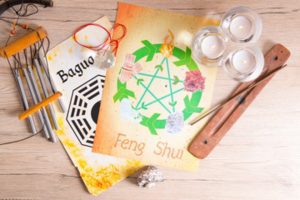The History of Feng Shui
Feng shui (pinyin: fēng shuǐ, literally “wind-water” in English) is a thousand-year-old Chinese art form. It is related to Taoist Arts. It shares a core outline of knowledge with Taoism, as does Chinese medicine or acupuncture.
The Chinese regard Feng Shui as a life philosophy that allows them to live in accordance with natural laws. For centuries, they used Feng Shui to plan cities, build houses, and bury their dead.
Similarly, the architects of all major Chinese monuments, such as Beijing’s Forbidden City and the Great Wall of China, were inspired by Feng Shui principles. Giving their architecture the necessary harmony to integrate with nature.
Formerly known as “Kan Yu,” the term “Feng Shui” first appeared in The Zangshu, or “Book of Burial,” written by Guo Pu (276-324 AD). According to the Classic, Qi rides the wind and scatters, but is retained when it comes into contact with water.

The ancients gathered it to prevent it from dissipating and guided it to ensure its preservation. As a result, it was given the name Fengshui. According to Fengshui principles, the site that attracts water is the best, followed by the site that catches wind.”
The “Kan Yu” way of the sky and Earth evolved during the Han dynasty (206 BC – 220 AD).
It arose from the observation of the strengths between heaven and earth, as well as the study of the environment (mountains and water) with regard to their shape and direction. The contents of the system San He today are the result of these observations.
To apply Feng Shui philosophy, two essential components must be considered: the complementary concepts of Yin and Yang, as well as the five elements (Water, Earth, Fire, Metal, Wood), which are often expressed through materials, forms, and colors.
Apart from that, Feng Shui ideology revolves around the Chi, which is the energy of the sum of the energy movements that govern the Universe.

For several thousand years, astrologers and wise men in ancient China laid the groundwork for Feng Shui. According to legend, the compass was invented during the reign of the Yellow Emperor. It was initially used for navigation.
It was later adapted for use in Feng Shui. For the people of former China, natural elements such as wind and water capture the energy of the sky and the earth. When this energy is in motion, it is either excessive or stagnant, and it has destructive qualities.
The first Chinese tribes were led by kings-shamans who understood wind and water and wielded power over the elements. One of them was the wise man Fu Xi, who is now revered as the guardian of science and divination. Particularly since he discovered He Tu (the cyclic behavior of the river He).
King Wen was the first to use Bagua (eight trigrams) to describe the changes in the world at the beginning of the Zhou dynasty (c. 1050–256 BC).
The Chinese used the Bagua theory and changed laws around the 8th century B.C. It was advocated for the palace to prosper and flourish, as well as for the court to be harmonious. Interestingly, feng shui evolved over time, particularly during the Tang and Song Dynasties (June 18, 618 to June 1, 907 AD) (960-1279). There were hundreds of Feng Shui schools during this time period.
The Qing Dynasty was the final stage of feng shui development (1644-1911). It happened later, during the Republican era (1912-1949). The Eight Mansions System, or Ba Zhai, was developed and applied exclusively to house Feng Shui in the early Qing Dynasty. Ba Zhai attempts to tune the protective celestial body of the house’s occupants.
The Xuan Kong school of thought integrated geological information during the Republican period. The astronomy of “flight patterns of dynamic stars” is the foundation of the Xuan Kong School of Feng Shui Systems.
It had a serious impact on the sides and roofs of occupants who lived in enclosed spaces for at least three years during the three yuans or eras of nine yuns or periods. The human residence or shop space that meets this prognosis is the most common interpretation of this criterion.
Feng Shui has based on the principle that everything around us recovers from the universal energy.

There is an immeasurable and limitless subtle substance that composes the entire cosmos and circulates in the world that surrounds us, in our body, and in our spirit. It is known as Chi in China, Ki in Japan, and Prana in India.
Thus, the goal of Feng Shui is to ensure that this air lungful of life circulates optimally inside and outside of us. This good circulation ensures a positive attitude, thoughts, and feelings that are directly related to our health, family, and professional life.
It is thus critical to ensure that the Chi circulates freely and sweetly within our homes. Any protruding angles, deep recesses, or overcrowded spaces create a significant energy barrier. This often leads to conflict and dysfunction in our lives.
This concept of free energy circulation is not unique to Feng Shui. It is derived from Chinese philosophy and serves as the foundation for certain thousand-year-old Chinese therapies such as acupuncture and shiatsu.
Both deviate from this principle. The mind, body (different organs), and immediate environment of a person form a whole, and any disorder, whether mental, physical, or external, can disrupt its energy balance and lead to disease or weakness.
